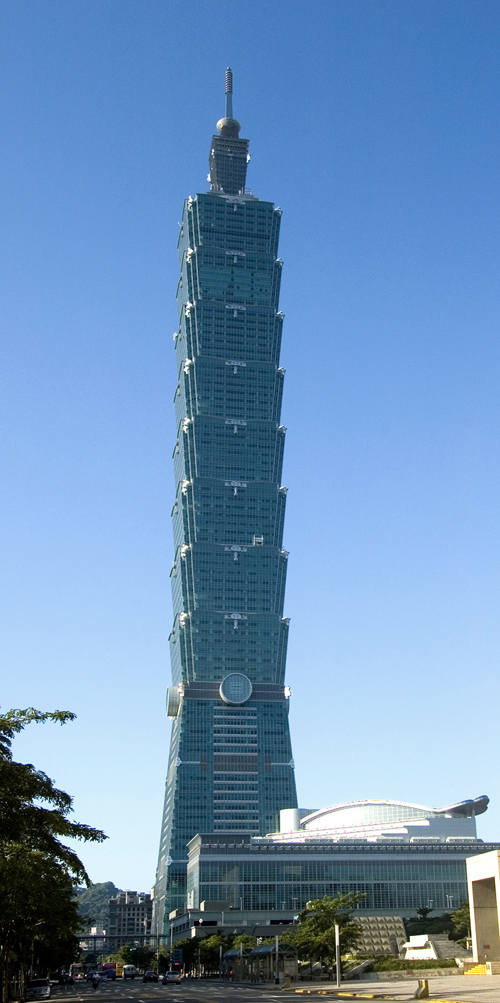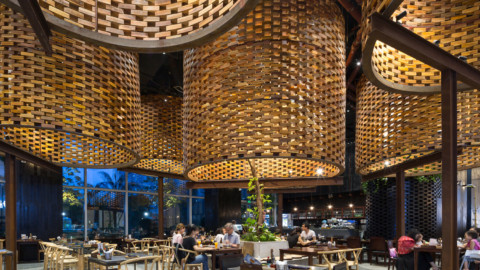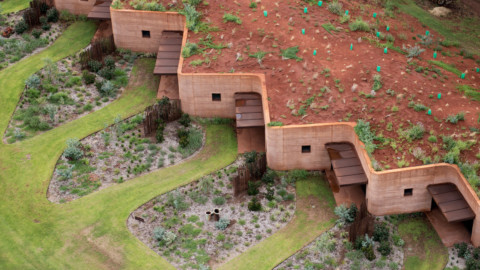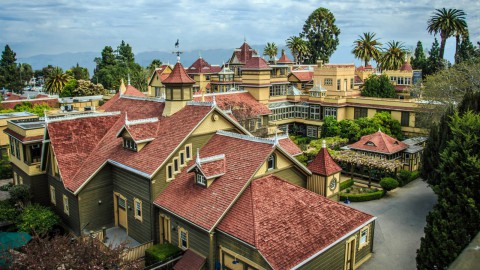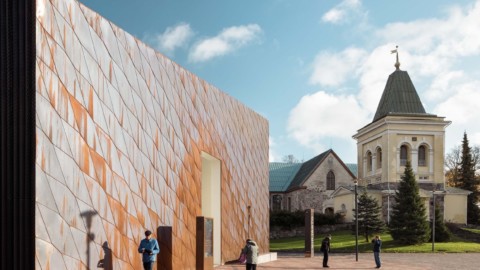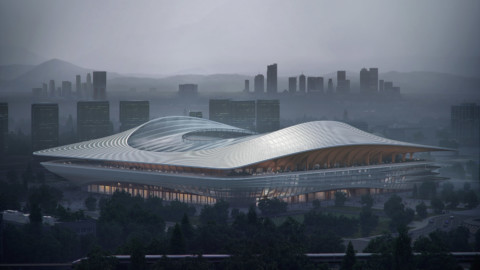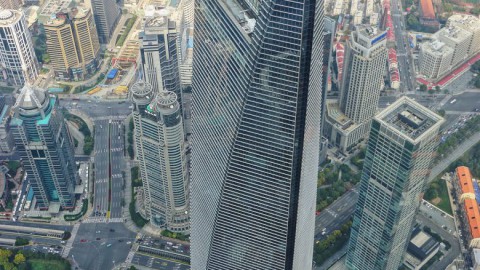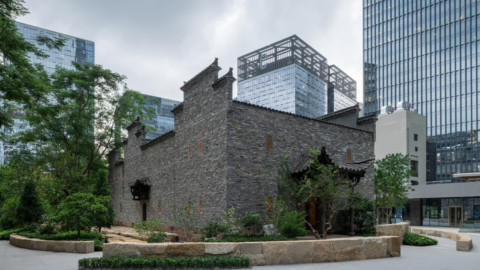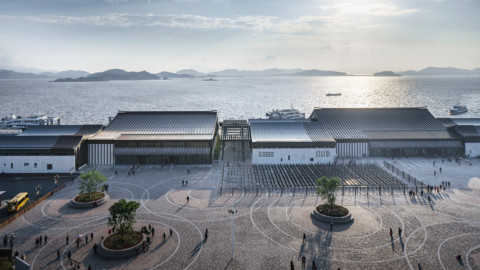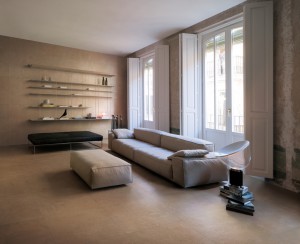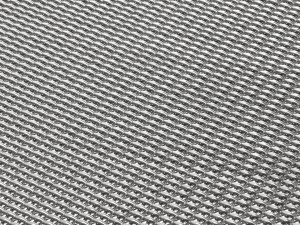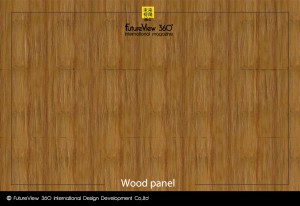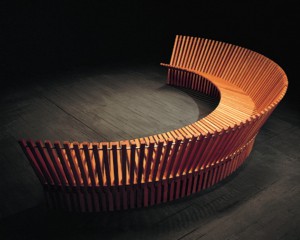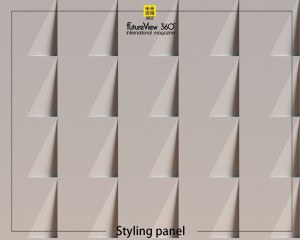Taipei 101 台北101
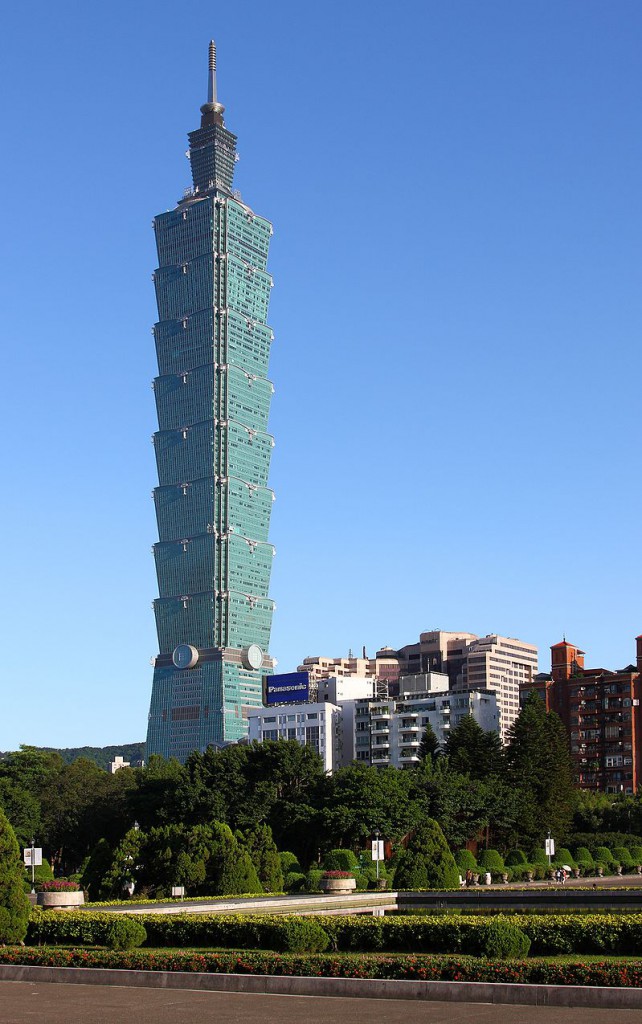
Taipei 101 / TAIPEI 101, formerly known as the Taipei World Financial Center – is a landmark supertall skyscraper in Xinyi District, Taipei, Taiwan. The building was officially classified as the world’s tallest in 2004, and remained such until the completion of the Burj Khalifa in Dubai in 2010. In 2011, the building was awarded the LEED platinum certification, the highest award according to the Leadership in Energy and Environmental Design(LEED) rating system, and became the tallest and largest green building in the world.At one point it had the fastest elevator in the world, traveling at 60.6 km/h (37.7 mph) and transporting passengers from the 5th to 89th floor in 37 seconds.
Construction on the 101-story tower started in 1999 and finished in 2004. The tower has served as an icon of modern Taiwan ever since its opening. The building was architecturally created as a symbol of the evolution of technology and Asian tradition. Its postmodernist approach to style incorporates traditional design elements and gives them modern treatments. The tower is designed to withstand typhoons and earthquakes. A multi-level shopping mall adjoining the tower houses hundreds of stores, restaurants and clubs. 2004 to present, fireworks launched from Taipei 101 feature prominently in international New Year’s Eve broadcasts and the structure appears frequently in travel literature and international media.
Taipei 101 is owned by Taipei Financial Center Corporation. The name that was originally planned for the building, Taipei World Financial Center, until 2003, was derived from the name of the owner.
台北101 /台北101,前身為台北世界金融中心 – 是台灣台北信義區的標誌性超高層摩天大樓。該建築在2004年被正式列為世界最高建築,直到2010年迪拜哈利法塔建成之前一直如此。2011年,該建築獲得LEED白金認證,是能源與環境領導者的最高獎項。設計(LEED)評級系統,並成為世界上最高和最大的綠色建築。有一點它擁有世界上最快的電梯,以60.6公里/小時(37.7英里/小時)的速度行駛,並將乘客從第5層運送到89層在37秒內。
這座101層高的塔樓於1999年建成,並於2004年完工。塔樓自開業以來一直是現代台灣的標誌。該建築在建築上被創造為技術和亞洲傳統演變的象徵。它的後現代主義風格融合了傳統的設計元素,並為其提供現代化的護理。該塔設計用於抵禦颱風和地震。毗鄰塔樓的多層購物中心擁有數百家商店,餐館和俱樂部。 2004年至今,台北101推出的煙花在國際新年前夜廣播中佔據突出地位,其結構經常出現在旅遊文學和國際媒體上。
台北101由台北金融中心公司擁有。最初計劃用於建築的名稱,台北世界金融中心,直到2003年,來自業主的名稱。
Type:Commercial offices
Architectural style:Postmodern
Location:Xinyi Special District, Xinyi District
Taipei, Taiwan
Coordinates:25°2′1″N 121°33′54″ECoordinates: 25°2′1″N 121°33′54″E
Construction started:1999
Completed:2004
Opening 31 December 2004
Owner:Taipei Financial Center Corporation
Management:Urban Retail Properties
Height
Architectural:509.2 m (1,671 ft)
Tip:509.2 m (1,671 ft)
Roof:449.2 m (1,474 ft)
Top floor:439.2 m (1,441 ft)
Observatory 391.8 m (1,285 ft)
Technical details
Floor count:101
5 below ground
Floor area:412,500 m2 (4,440,100 sq ft)
Lifts/elevators:61 Toshiba/KONE elevators, including double-deck shuttles and 2 high speed observatory elevators
Design and construction
Architect:C.Y. Lee & Partners
Main contractor:KTRT Joint Venture
類型:商業辦公室
建築風格:後現代主義
地點:信義區信義特區
台北,台灣
坐標:25°2’1“N 121°33’54”ECoordinates:25°2’1“N 121°33’54”E
建設開始於:1999年
竣工時間:2004年
2004年12月31日開幕
業主:台北金融中心公司
管理:城市零售物業
高度
建築:509.2米(1,671英尺)
提示:509.2米(1,671英尺)
屋頂:449.2米(1,474英尺)
頂樓:439.2米(1,441英尺)
天文台391.8米(1,285英尺)
技術細節
樓層數:101
5地下
建築面積:412,500平方米(4,440,100平方英尺)
電梯/電梯:61台東芝/通力電梯,包括雙層班車和2部高速天文台電梯
設計和施工
建築師:C.Y. 李和夥伴
主承包商:KTRT合資企業
Features
Height
Taipei 101 comprises 101 floors above ground, as well as 5 basement levels. It was not only the first building in the world to break the half-kilometer mark in height, but also the world’s tallest building from March 2004 to 10 March 2010. As of 28 July 2011, it is still the world’s largest and highest-use green building.
Upon its completion, Taipei 101 was the world’s tallest inhabited building, at 509.2 m (1,671 ft) as measured to its height architectural top (spire), exceeding the Petronas Towers, which were previously the tallest inhabited skyscraper at 451.9 m (1,483 ft). The height to the top of the roof, at 449.2 m (1,474 ft), and highest occupied floor, at 439.2 m (1,441 ft), surpassed the previous records of 442 m (1,450 ft) and 412.4 m (1,353 ft), respectively; the Willis Tower had previously held that distinction. It also surpassed the 85-story, 347.5 m (1,140 ft) Tuntex Sky Tower in Kaohsiung as the tallest building in Taiwan and the 51-story, 244.15 m (801 ft) Shin Kong Life Tower as the tallest building in Taipei. Taipei 101 claimed the official records for the world’s tallest sundial and the world’s largest New Year’s Eve countdown clock.
Various sources, including the building’s owners, give the height of Taipei 101 as 508 m (1,667 ft), roof height and top floor height as 448 m (1,470 ft) and 438 m (1,437 ft). This lower figure is derived by measuring from the top of a 1.2 m (4 ft) platform at the base. CTBUH standards, though, include the height of the platform in calculating the overall height, as it represents part of the man-made structure and is above the level of the surrounding pavement. Taipei 101 displaced the Petronas Towers as the tallest building in the world by 57.3 m (188 ft). The record it claimed for greatest height from ground to pinnacle was surpassed by the Burj Khalifa in Dubai, which is 829.8 m (2,722 ft) in height. Taipei 101’s records for roof height and highest occupied floor briefly passed to the Shanghai World Financial Center in 2008, which in turn yielded these records as well to the Burj.
特徵
高度
台北101樓高101層,地下5層。它不僅是世界上第一座打破半公里高度的建築,而且是2004年3月至2010年3月10日世界上最高的建築。截至2011年7月28日,它仍然是世界上最大和最高用途的建築。綠色建築。
台北101建成後,是世界上最高的有人居住建築,高509米(1,671英尺),高度為建築頂部(尖頂),超過了雙子塔,這是以前最高的有人居住的摩天大樓,海拔451.9米(1,483英尺) 。屋頂頂部高度為449.2米(1,474英尺),最高佔地面積為439.2米(1,441英尺),分別超過之前442米(1,450英尺)和412.4米(1,353英尺)的記錄。 ;威利斯大廈以前曾有過這種區別。它還超過了位於高雄的85層,347.5米(1,140英尺)的Tuntex Sky Tower作為台灣最高的建築,以及作為台北最高建築的51層,244.15米(801英尺)的新光生活大廈。台北101號公佈了世界上最高的日and和世界上最大的新年前夜倒計時鐘的正式記錄。
包括建築物所有者在內的各種資源,台北101的高度為508米(1,667英尺),屋頂高度和頂層高度分別為448米(1,470英尺)和438米(1,437英尺)。這個較低的數字是通過從底部1.2米(4英尺)平台的頂部進行測量得出的。但是,CTBUH標準包括平台在計算總高度時的高度,因為它代表了人造結構的一部分,高於周圍路面的高度。台北101號將Petronas Towers作為世界上最高的建築物取代了57.3米(188英尺)。迪拜的哈利法塔(Burj Khalifa)高度為829.8米(2,722英尺),超過了從地面到頂峰的最高高度。台北101的屋頂高度和最高佔地面積的記錄在2008年短暫地傳遞到了上海環球金融中心,而這些記錄又將這些記錄輸出到了Burj。
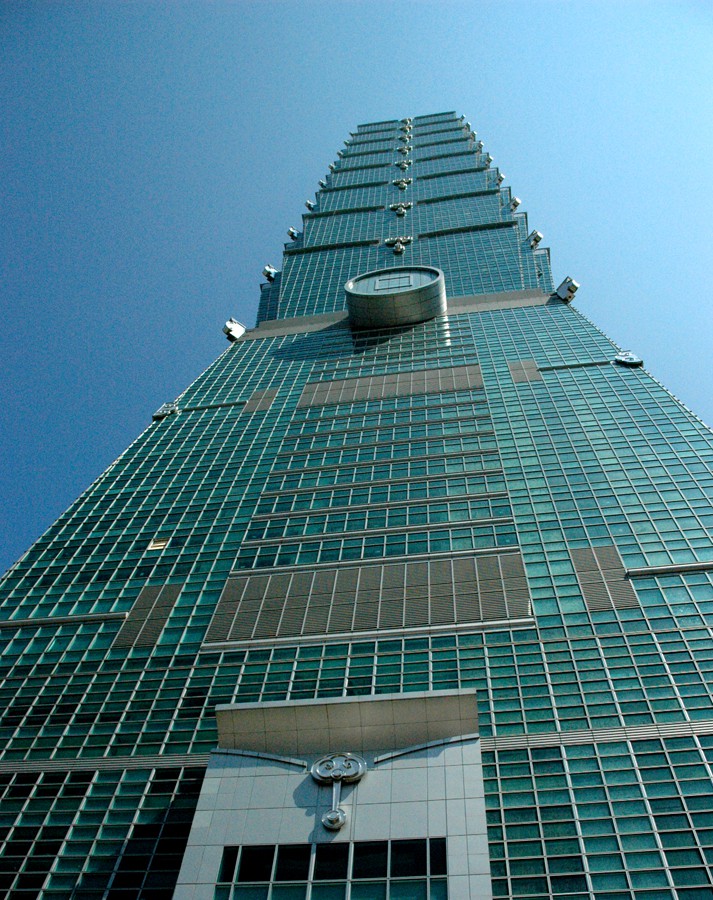
Structural design
Location of Taipei 101’s largest tuned mass damper
Taipei 101 is designed to withstand the typhoon winds and earthquake tremors that are common in the area east of Taiwan. Evergreen Consulting Engineering, the structural engineer, designed Taipei 101 to withstand gale winds of 60 metres per second (197 ft/s), (216 km/h or 134 mph), as well as the strongest earthquakes in a 2,500-year cycle.
Taipei 101 was designed to be flexible as well as structurally resistant, because while flexibility prevents structural damage, resistance ensures comfort for the occupants and for the protection of glass, curtain walls, and other features. Most designs achieve the necessary strength by enlarging critical structural elements such as bracing. Because of the height of Taipei 101, combined with the surrounding area’s geology—the building is located just 660 ft (200 m) away from a major fault line—Taipei 101 used high-performance steel construction and 36 columns, including eight “mega-columns” packed with 10,000 psi (69 MPa) concrete. Outrigger trusses, located at eight-floor intervals, connect the columns in the building’s core to those on the exterior.
These features, combined with the solidity of its foundation, made Taipei 101 one of the most stable buildings ever constructed.[citation needed] The foundation is reinforced by 380 piles driven 80 m (262 ft) into the ground, extending as far as 30 m (98 ft) into the bedrock. Each pile is 1.5 m (5 ft) in diameter and can bear a load of 1,000–1,320 tonnes (1,100–1,460 short tons). During construction, on 31 March 2002, a 6.8-magnitude earthquake rocked Taipei; two construction cranes from the 56th floor, the highest floor at the time, toppled. Five people died in the accident, but an inspection showed no structural damage to the building, and construction soon resumed.
RWDI designed a 660-tonne (728-short-ton) steel pendulum that serves as a tuned mass damper, at a cost of NT$132 million (US$4 million). Suspended from the 92nd to the 87th floor, the pendulum sways to offset movements in the building caused by strong gusts. Its sphere, the largest damper sphere in the world, consists of 41 circular steel plates of varying diameters, each 125 mm (4.92 in) thick, welded together to form a 5.5 m (18 ft) diameter sphere. Two additional tuned mass dampers, each weighing 6 tonnes (7 short tons), are installed at the tip of the spire which help prevent damage to the structure due to strong wind loads. On 8 August 2015, strong winds from Typhoon Soudelor swayed the main damper by 100 centimetres (39 in) – the largest movement ever recorded by the damper.
The damper has become such a popular tourist attraction, the city contracted Sanrio to create a mascot: the Damper Baby. Four versions of the Damper Baby: “Rich Gold”, “Cool Black”, “Smart Silver” and “Lucky Red” were designed and made into figurines and souvenirs sold in various Taipei 101 gift shops. Damper Baby, with its cute all-ages appeal, has become a popular local icon, with its own comic book and website.
結構設計
台北101最大的調諧質量阻尼器的位置
台北101的設計是為了抵禦台灣以東地區常見的颱風和地震。結構工程師Evergreen Consulting Engineering設計的台北101能夠承受每秒60米(197英尺/秒),(216公里/小時或134英里/小時)的大風,以及2500年周期內最強烈的地震。
台北101的設計靈活且結構耐用,因為雖然靈活性可防止結構損壞,但阻力確保了乘客的舒適性以及玻璃,幕牆和其他特徵的保護。大多數設計通過擴大關鍵結構元素(如支撐)來獲得必要的強度。由於台北101的高度,加上周邊地區的地質 – 該建築距離主要斷層線僅660英尺(200米) – 台北101使用高性能鋼結構和36列,其中包括8個“巨型” “填充10,000 psi(69 MPa)混凝土的柱子。位於八層樓的支腿桁架將建築物核心的柱子連接到外部的柱子上。
這些特徵加上其基礎的堅固性,使台北101成為有史以來建造最穩定的建築之一。[引證需要]基礎由380磅樁加固到地面80米(262英尺),延伸至30 m(98英尺)進入基岩。每個樁的直徑為1.5米(5英尺),可承受1,000-1,320噸(1,100-1,460短噸)的負荷。在施工期間,2002年3月31日,一場6.8級地震震動了台北;從當時最高層56層的兩台建築起重機倒塌。事故造成5人死亡,但檢查顯示建築物沒有結構性損壞,施工很快恢復。
RWDI設計了一個660噸(728短噸)的鋼製擺錘,作為一個調諧質量阻尼器,耗資1.32億新台幣(400萬美元)。從第92層懸掛到第87層,擺錘搖擺以抵消強烈陣風造成的建築物移動。它的球體是世界上最大的阻尼球體,由41個不同直徑的圓形鋼板組成,每個厚125毫米(4.92英寸),焊接在一起形成一個5.5米(18英尺)直徑的球體。兩個額外的調諧質量阻尼器,每個重6噸(7短噸),安裝在尖頂的尖端,有助於防止由於強風荷載造成的結構損壞。 2015年8月8日,來自Typhoon Soudelor的強風使主減震器搖晃100厘米(39英寸) – 這是阻尼器記錄的最大機芯。
阻尼器已成為如此受歡迎的旅遊景點,該城市與Sanrio簽約創建了一個吉祥物:Damper Baby。 Damper Baby的四個版本:“Rich Gold”,“Cool Black”,“Smart Silver”和“Lucky Red”被設計並製作成在各種台北101禮品店出售的小雕像和紀念品。 Damper Baby憑藉其可愛的無時尚魅力,已成為當地流行的偶像,擁有自己的漫畫書和網站。
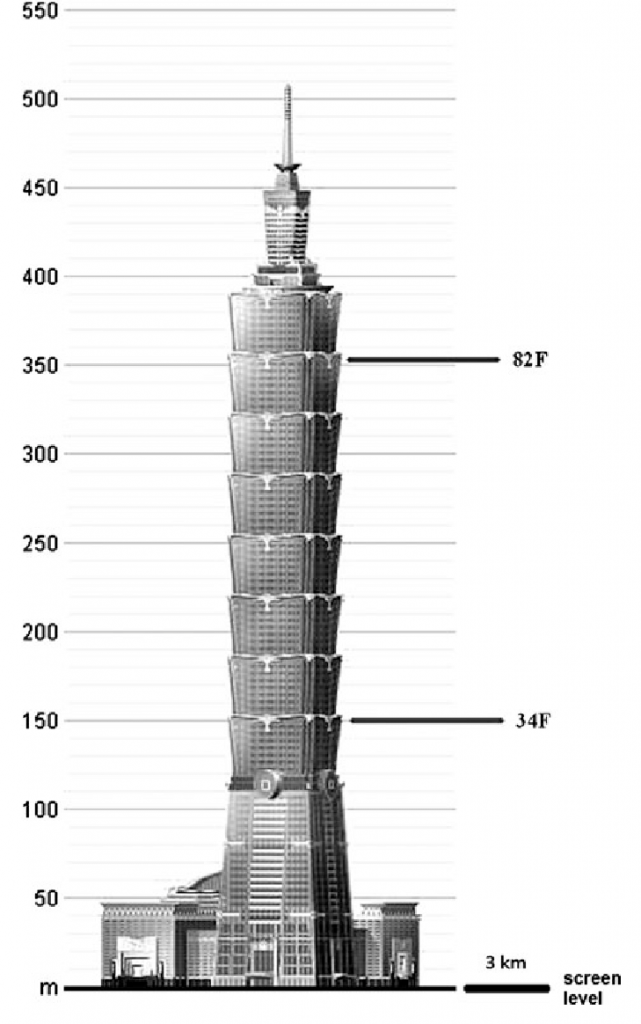
Structural façade
Taipei 101 during a typhoon
View from the base of the tower, looking up
Ruyi figure over one of the building’s entrances
Shadow of the tower in the late afternoon; the adjoining park (circular feature, bottom) acts as the face of a sundial.
Feng shui fountain outside Taipei 101
Taipei 101’s characteristic blue-green glass curtain walls are double paned and glazed, offer heat and UV protection sufficient to block external heat by 50 percent, and can sustain impacts of 7 tonnes (8 short tons). The façade system of glass and aluminum panels installed into an inclined moment-resisting lattices contributes to overall lateral rigidity by tying back to the mega-columns with one-story high trusses at every eighth floor. This façade system is therefore able to withstand up to 95 mm (4 in) of seismic lateral displacements without damage.
The original corners of the façade were tested at RWDI in Ontario. A simulation of a 100-year storm at RWDI revealed a vortex that formed during a 3-second 105 miles per hour (169 km/h) wind at a height of 10 meters, or equivalent to the lateral tower sway rate causing large crosswind oscillations. A double chamfered step design was found to dramatically reduce this crosswind oscillation, resulting in the final design’s “double stairstep” corner façade. Architect C.Y. Lee also used extensive façade elements to represent the symbolic identity he pursued. These façade elements included the green tinted glass for the indigenous slender bamboo look, eight upper outwards inclined tiers of pagoda each with eight floors, a Ruyi and a money box symbol between the two façade sections among others.
Taipei 101’s own roof and façade recycled water system meets 20 to 30 percent of the building’s water needs. In July 2011, Taipei 101 was certified “the world’s tallest green building” under LEED standards.
結構立面
颱風101在颱風期間
查看從塔的基地,抬頭
如意在建築物的入口之一
塔下的陰影在下午晚些時候;相鄰的公園(圓形特徵,底部)充當日的臉。
台北101外的風水噴泉
台北101的特色藍綠色玻璃幕牆採用雙層玻璃幕牆,提供足夠的熱量和紫外線防護,可將外部熱量阻擋50%,並可承受7噸(8短噸)的衝擊。玻璃和鋁板的外立面系統安裝在一個傾斜的抗彎矩陣中,通過將每八層一層高的桁架系在一起的大柱上,有助於提高整體橫向剛度。因此,這種立面系統能夠承受高達95毫米(4英寸)的地震橫向位移而不會造成損壞。
立面的原始角落在安大略省的RWDI進行了測試。在RWDI進行的一次為期100年的風暴模擬顯示,在10米高度的3秒105英里/小時(169公里/小時)風中形成一個渦旋,或相當於橫向塔搖擺率導致大的側風振盪。發現雙倒角台階設計可以顯著減少這種側風振盪,從而形成最終設計的“雙階梯”角落立面。建築師C.Y.李還使用了廣泛的外觀元素來代表他追求的象徵性身份。這些立面元素包括用於本土細長竹子外觀的綠色有色玻璃,八個向上傾斜的寶塔層,每層有八層樓,兩個外立面之間的如意和錢箱符號等。
台北101自己的屋頂和立面循環水系統可滿足建築物20%至30%的用水需求。 2011年7月,台北101在LEED標準下被認定為“世界上最高的綠色建築”。
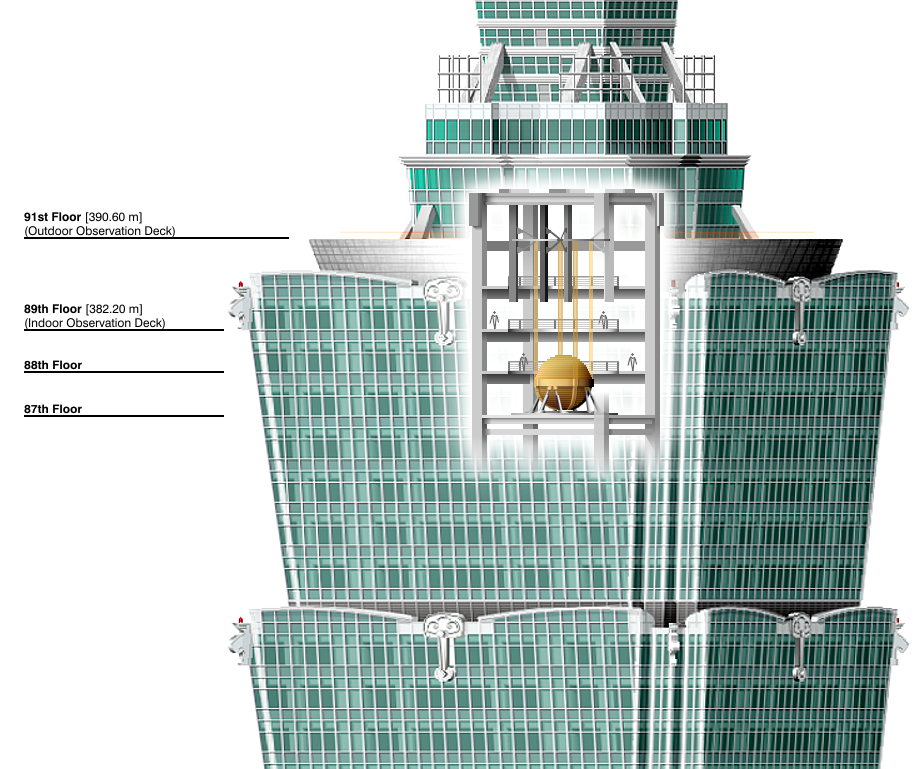
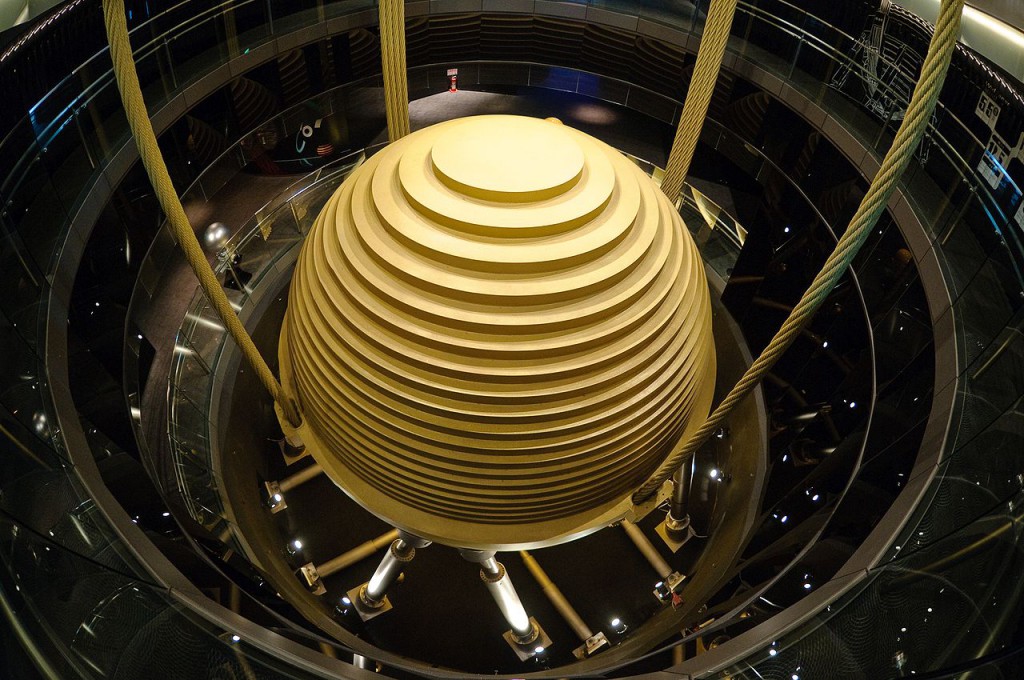
Symbolism
Taipei 101 in the skyline.
The height of 101 floors commemorates the renewal of time: the new century that arrived as the tower was built (100+1) and all the new years that follow (1 January = 1-01). It symbolizes high ideals by going one better on 100, a traditional number of perfection. The number also evokes the binary numeral system used in digital technology.
The main tower features a series of eight segments of eight floors each. In Chinese-speaking cultures the number eight is associated with abundance, prosperity and good fortune.
The repeated segments simultaneously recall the rhythms of an Asian pagoda (a tower linking earth and sky, also evoked in the Petronas Towers), a stalk of bamboo (an icon of learning and growth), and a stack of ancient Chinese ingots or money boxes (a symbol of abundance). Popular humor sometimes likens the building’s shape to a stack of take-out boxes as used in Western-style Chinese food; of course, the stackable shape of such boxes is likewise derived from that of ancient money boxes.The four discs mounted on each face of the building where the pedestal meets the tower represent coins. The emblem placed over entrances shows three gold coins of ancient design with central holes shaped to imply the Arabic numerals 1-0-1.The structure incorporates many shapes of squares and circles to reach a balance between yin and yang.
Curled ruyi figures appear throughout the structure as a design motif. Though the shape of each ruyi at Taipei 101 is traditional, its rendering in industrial metal is plainly modern. The ruyi is a talisman of ancient origin associated in art with heavenly clouds. It connotes healing, protection and fulfillment. It appears in celebrations of the attainment of new career heights. The sweeping curved roof of the adjoining mall culminates in a colossal ruyi that shades pedestrians. Each ruyi ornament on the exterior of the Taipei 101 tower stands at least 8 m (26 ft) tall.
At night the bright yellow gleam from its pinnacle casts Taipei 101 in the role of a candle or torch upholding the ideals of liberty and welcome. From 6:00 to 10:00 each evening the tower’s lights display one of seven colors in the spectrum. The colors coincide with the days of the week:
Monday Tuesday Wednesday Thursday Friday Saturday Sunday
red orange yellow green blue violet purple
The adjoining Taipei 101 on the east side connects the landmark further with the symbolism of time. The design of the circular park doubles as the face of a giant sundial. The tower itself casts the shadow to mark afternoon hours for the building’s occupants. The park’s design is echoed in a clock that stands at its entrance. The clock runs on energy drawn from the building’s wind shear.
Taipei 101, like many of its neighbours, shows the influence of feng shui philosophy. An example appears in the form of a large granite fountain at the intersection of Songlian Road and Xinyi Road near the tower’s east entrance. A ball at the fountain’s top spins toward the tower. As a work of public art the fountain offers a contrast to the tower in texture even as its design echoes the tower’s rhythms. The fountain also serves a practical function in feng shui philosophy. A T intersection near the entrance of a building represents a potential drain of positive energy, or ch’i, from a structure and its occupants.Placing flowing water at such spots is thought to help redirect the flow of ch’i.
象徵
台北101在天際線。
101層的高度紀念時間的更新:塔樓建成後的新世紀(100 + 1)以及隨後的所有新年(1月1日= 1月1日)。它像徵著崇高的理想,通過在100上取得更好,這是傳統的完美數字。這個數字也喚起了數字技術中使用的二進制數字系統。
主塔有一系列八段,每層八層。在講中文的文化中,八號與豐富,繁榮和好運有關。
重複的片段同時回憶起亞洲寶塔的節奏(連接地球和天空的塔,也在雙子塔中引起),竹稈(學習和成長的象徵),以及一堆古老的中國錠或錢箱(豐富的象徵)。流行的幽默有時會將建築物的形狀比作西式中式食物中使用的一堆外賣盒;當然,這種盒子的可堆疊形狀同樣來源於古錢箱的形狀。安裝在建築物每個面上的四個圓盤代表硬幣。放置在入口處的標誌顯示了三個古代設計的金幣,中央孔形狀意味著阿拉伯數字1-0-1。結構包含許多形狀的正方形和圓形,以達到陰陽之間的平衡。
捲曲的如意圖在整個結構中作為設計主題出現。雖然台北101的每個如意的形狀都是傳統的,但它在工業金屬中的渲染顯然是現代的。如意是古代起源的護身符,與天上的雲彩相關。它意味著癒合,保護和實現。它出現在實現新的職業生涯高度的慶祝活動中。相鄰購物中心的寬闊弧形屋頂最終形成一個巨大的如意,遮蔽了行人。台北101大廈外部的每一件裝飾品至少高8米(26英尺)。
晚上,來自巔峰的亮黃色燈光投射了台北101,扮演蠟燭或火炬,維護著自由和歡迎的理想。從每晚6點到10點,塔樓的燈光顯示光譜中的七種顏色中的一種。顏色與一周中的日期一致:
週一 周二 週三 週四 周五 週六 週日
紅 橙 黃 綠 藍 淡紫 紫
東側毗鄰的台北101連接著具有時代象徵意義的地標。圓形公園的設計兼作巨型日..的面貌。塔樓本身投下陰影,以紀念建築物居住者的下午時間。公園的設計與入口處的鐘錶相呼應。時鐘以建築物的風切變產生的能量運行。
與許多鄰國一樣,台北101展示了風水哲學的影響力。一個例子是在松林路與新沂路交叉口的大型花崗岩噴泉的形式,靠近塔的東入口。噴泉頂部的一個球向塔身旋轉。作為公共藝術作品,噴泉與塔的質感形成鮮明對比,即使其設計與塔的節奏相呼應。噴泉還具有風水哲學的實用功能。建築物入口附近的T交叉點表示來自結構及其占用者的正能量或氣的潛在消耗。在這些點處放置流動的水被認為有助於改變氣的流動。
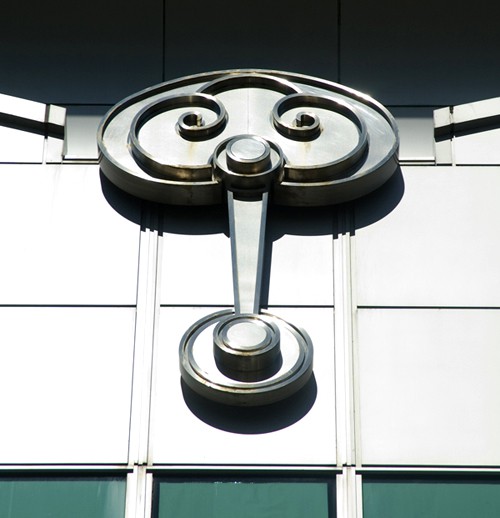
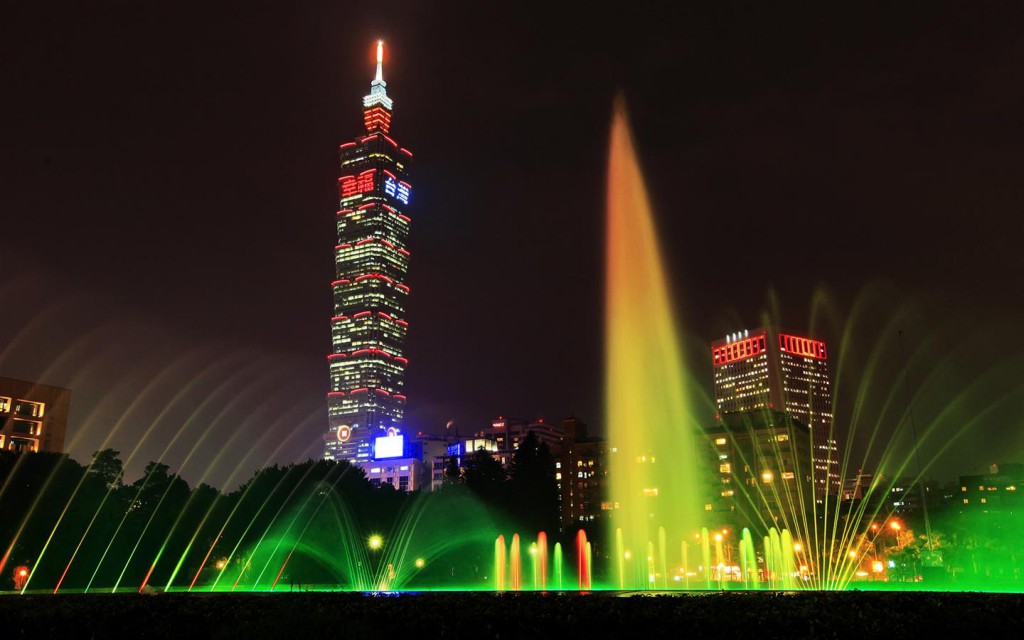
Art
Many works of art appear in and around Taipei 101. These include: German artist Rebecca Horn’s Dialogue between Yin and Yang in 2002 (steel, iron), American artist Robert Indiana’s 1-0 in 2002 and Love in 2003 (aluminum), French artist Ariel Moscovici’s Between Earth and Sky in 2002 (rose de la claret granite), Taiwanese artist Chung Pu’s Global Circle In 2002 (black granite, white marble), British artist Jill Watson’s City Composition in 2002 (Bronze), and Taiwanese artist Kang Mu Hsiang’s Infinite Life in 2013 (aluminum).Moreover, the Indoor Observatory hosts a regular series of exhibitions. The artists represented have included Wu Ching (gold sculpture), Ping-huang Chang (traditional painting) and Po-lin Chi (aerial photography).
藝術
許多藝術作品出現在台北101及其周圍。其中包括:德國藝術家麗貝卡·霍恩2002年的陰陽對話(鋼鐵),美國藝術家羅伯特·印第安納的2002年1-0,2003年的愛情(鋁),法國藝術家 Ariel Moscovici在2002年的地球與天空之間(玫瑰de la claret花崗岩),台灣藝術家Chung Pu的環球圈2002年(黑色花崗岩,白色大理石),英國藝術家Jill Watson 2002年的城市作品(青銅)和台灣藝術家Kang Mu Hsiang的 2013年的無限生活(鋁)。此外,室內天文台還舉辦一系列定期展覽。 代表的藝術家包括吳清(金雕),張平衡(傳統繪畫)和寶林志(航空攝影)。
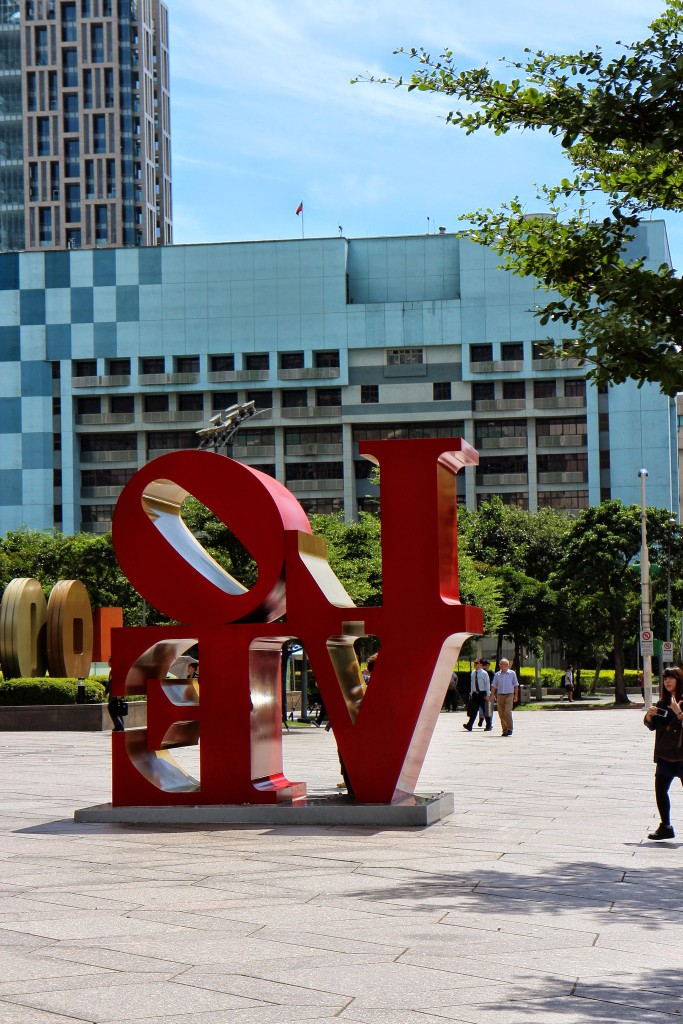

FROM:2018 TAIPEI 101 FIREWORKS (FULL VERSION) 4K. TAIPEI CITY, TAIWAN
FROM:2017 11 26 雲霧繚繞的TAIPEI 101 從白天到清晨縮時攝影之台北夜景特輯TAIPEI 101 Day to early morning timelapse (4k影片)
FROM:Time Lapse Of Taipei 101 (縮時攝影)
Don’t you think it’s addictive?
Want to know more about the beauty of architecture?
Come and join our members to explore the beauty of architectural design.
覺得看得不過癮嗎?
想要知道更多建築之美嗎?
快來加入我們的會員,一同探索建築設計之美。
The above article is purely for appreciation and sharing purposes, as well as the construction of new technology and the public can be in-depth understanding of the information at the same time there are sources, will be able to query, no use of the document as a commercial transaction, if illegal, please inform the We will immediately remove the site, thank you for cooperation.
以上文章純粹作為欣賞及分享用途,以及將建築新型技術傳遞給與大眾能夠深入了解,同時資料還有來源,將可查詢,絕無使用該文件資料作為商業交易行為,如有違法請務必告知該網站我們將立即處理撤除,謝謝合作。
FROM:2018 TAIPEI 101 FIREWORKS (FULL VERSION) 4K. TAIPEI CITY, TAIWAN
FROM:2017 11 26 雲霧繚繞的TAIPEI 101 從白天到清晨縮時攝影之台北夜景特輯TAIPEI 101 Day to early morning timelapse (4k影片)
FROM:Time Lapse Of Taipei 101 (縮時攝影)
Don’t you think it’s addictive?
Want to know more about the beauty of architecture?
Come and join our members to explore the beauty of architectural design.
覺得看得不過癮嗎?
想要知道更多建築之美嗎?
快來加入我們的會員,一同探索建築設計之美。
The above article is purely for appreciation and sharing purposes, as well as the construction of new technology and the public can be in-depth understanding of the information at the same time there are sources, will be able to query, no use of the document as a commercial transaction, if illegal, please inform the We will immediately remove the site, thank you for cooperation.
以上文章純粹作為欣賞及分享用途,以及將建築新型技術傳遞給與大眾能夠深入了解,同時資料還有來源,將可查詢,絕無使用該文件資料作為商業交易行為,如有違法請務必告知該網站我們將立即處理撤除,謝謝合作。

